Best cycling shoes 2025 rated and reviewed
The best cycling shoes will make your rides more comfortable, more efficient and more enjoyable
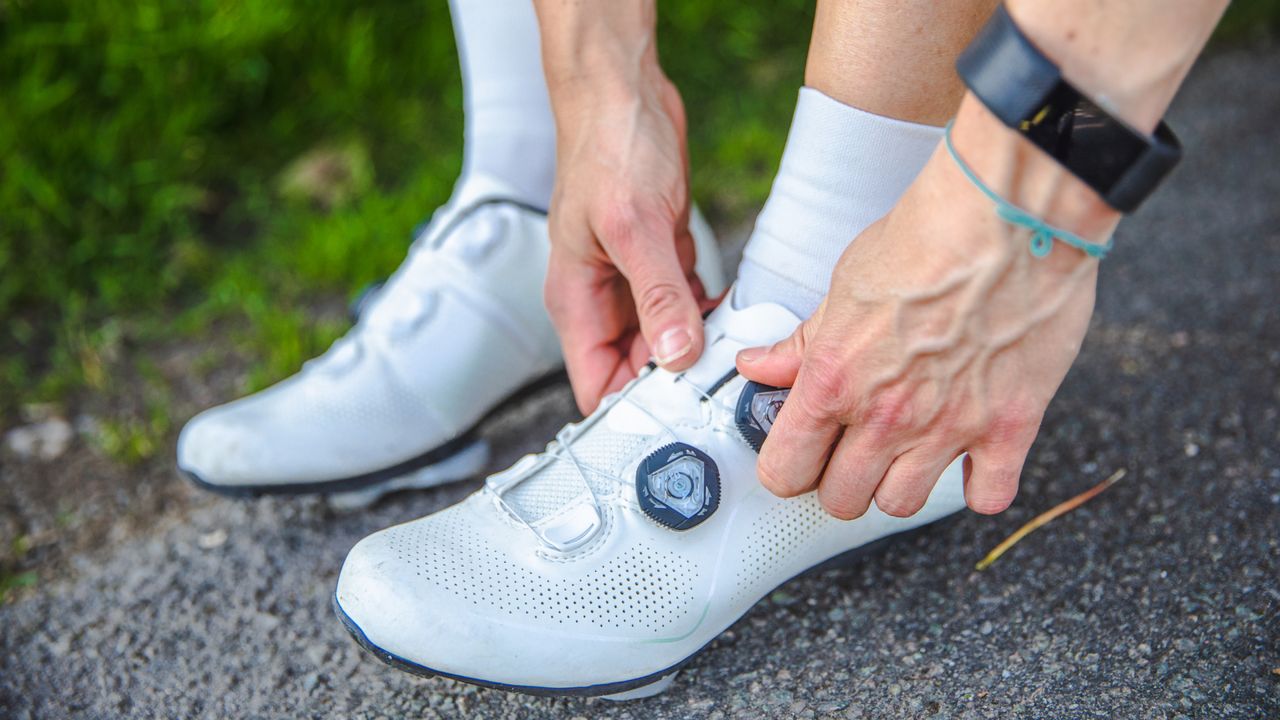

Fit is paramount when it comes to cycling shoes. Of the three contact points on a bicycle, there’s arguably nothing more critical than shoes: they are at the nexus of the energy transfer between body and bicycle. Sloppily fitted shoes prevent the power from each pedal stroke from efficiently making it into the drivetrain and propelling you forward. Every rider’s feet are different, however, which means that no single pair of shoes works best for everyone.
Within this guide are a few of the common closure systems for cycling shoes. Far and away the most popular are ratcheting dials—usually made by BOA—though there are some other proprietary designs on the market as well. Most high-end shoes use two BOA dials, whereas more entry-level ones have one. Another common closure system is laces. Laces are lighter than BOAs, allow for more fine-tuning of fit, and may be more aerodynamic. They are usually also cheaper. They can, however, be hard to adjust while on the bike.
When it comes to shoes, we recommend spending a little more, if you can. There are plenty of other places to save money that will not impede you from enjoying your time on the bike, but this is not the case with footwear. You’ll be happier, faster, and more comfortable on the bike with shoes that fit well. If that means shelling out a little more, then so be it, cheap shoes aren't really cheap if they are uncomfortable and need replacing sooner rather than later. For some of the best value shoes, have a read through our Best Budget Cycling Shoes guide.
However, the most expensive shoes won't necessarily be the best or most comfortable for you, so at the end of this guide we've included a few shoes that aren't quite top of the range, but still offer excellent performance. As the pro-level shoes are as stiff as possible for maximum power transfer, they can be uncomfortable for very long rides or if they don't fit your foot shape exactly. This is where these 'second tier' models come in - as they are slightly less stiff they are often a lot more comfortable.
If you enjoy riding off-road, then have a look at our best gravel bike shoes guide, whilst regular commuter bike users will want to look at our best cycling shoes for commuting suggestions.
The quick list
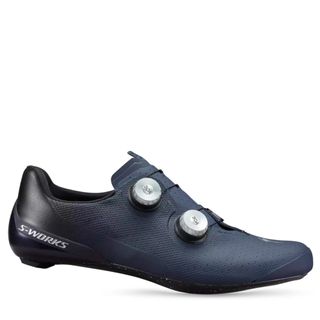
Best high-performance cycling shoe
Specialized’s S-Works Torch is supremely stiff and features the design elements that have made Specialized a leader in bike fitting expertise. Two BOA dials allow for precision fit and easy mid-ride adjustment, and notably, they are slightly wider than previous S-Works models.
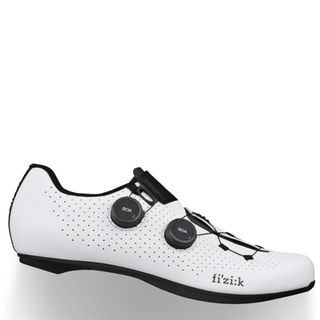
Best shoe blending performance and design
Fizik’s Vento Infinito Carbon 2 is the latest in a line of new and innovative shoes from the Italian company. It features two BOA dials, one of which is solely responsible for keeping the arch locked in place, and the carbon soles are among the stiffest on the market.

Best high-performance cycling shoe for hot weather
Giro continues to innovate with materials and its highest-end lace-up shoe, the Empire SLX, showcases how lightweight materials can transform a shoe into something so lightweight and breathable that it’s barely noticeable on the foot. The SLX also has an impressively low stack height for optimal pedaling dynamics.
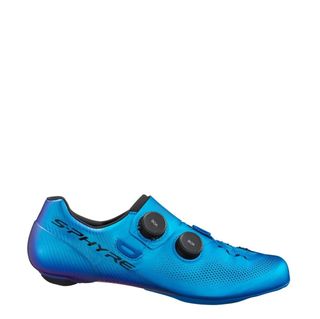
Best high-end cycling shoe
Twin BOA closure, excellent venting and two width fittings make Shimano's race shoe fantastic to ride in. The heel cup and toe box hold the foot very securely; perfect for a finish line sprint or climbing out of the saddle up double-digit gradients.
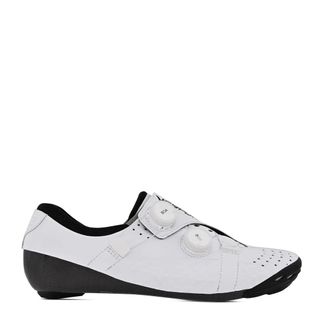
Best heat moldable shoe
Heat moldable for a personalised fit and available in a plethora of size / width options, the Vaypor S from Bont will be highly comfortable for many riders. The double BOA system provides easy on-the-go adjustment and the bathtub carbon sole provides great pedalling efficiency.
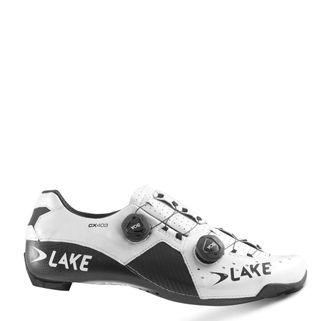
Best for wide feet
At the stiffer end of the spectrum, Lake's CX403 is ideal for racing but maybe not so perfect for all day cruising. However, there are wide fit options available and they can be heat molded multiple times, so a decent level of comfort can still be achieved.
Best high-performance cycling shoe
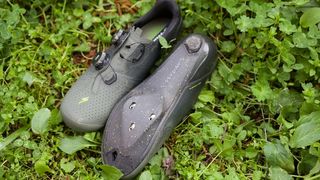
Specialized S-Works Torch our best performing shoe
Specialized S-Works Torch
Our expert review:
Specifications
Reasons to buy
Reasons to avoid
The S-Works Torch is Specialized’s top-of-the-line racing shoe, seen on the feet of Remco Evenepoel and other WorldTour animators of note. The S-Works Torch features two Boa S3 dials, an exceptionally stiff sole, and an asymmetrical heel cup. The sole has a single small vent under the toe, as well as a replaceable heel tread piece.
Specialized has refined its shoe designs over many iterations, and this latest version offers an impressive set of features. The shoe has been widened by 4 millimeters compared to the outgoing S-Works 7, and has a redesigned upper with material optimized specifically for each area of the foot.
The alloy dials are robust, and the back-and-forth style ratchet allows for easy fit micro-adjustment, however, the lack of a quick release feature (most BOA dials allow you to pull up the mechanism to release it all the way) means they’re slow to remove from your feet. The heels did an exceptionally good job holding my foot in place and preventing movement within the shoe. Specialized’s shoes are best for mid- to high-volume feet, especially in the toe box.
Specialized uses a fit philosophy called Body Geometry as part of the design of its shoes. The most notable feature of this is a slight outward cant to the shoe, which Specialized claims better aligns the knee and ankle. It won’t work for everyone (I need additional support in the other direction, for example) but is backed by the company’s research into pedal dynamics.
At 211 grams per shoe (size 40.5) the S-Works Torch is among the lightest shoes here, though they are also among the most expensive at $450.
On the road, the shoes operate like the WorldTour-proven footwear they are. Power transfer is exceptionally good, which is a function of both stiffness and the shape of the shoes, which held my feet in place firmly and left no room for extraneous movement. The two BOA dials are well placed to distribute pressure evenly over the foot and accommodate a variety of foot shapes. I find Specialized shoes to run slightly big, so usually choose a half-size smaller.
My only significant qualm with the S-Works Torch shoes is fit-related: the shape of the soles has a significant upward curve at the toe, which just doesn’t work well for my feet. I think it’s something that I could get used to, but it bothered me for the first few test rides. This may or not be an issue for you.
Best shoe blending performance and design
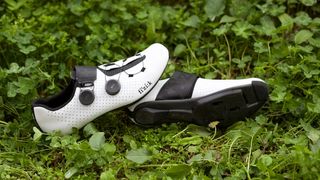
Fizik Vento Infinito Carbon 2
Fizik Vento Infinito Carbon 2
Our expert review:
Specifications
Reasons to buy
Reasons to avoid
Fizik has expanded its shoe range significantly over the last few years. As the shoe sponsor of Movistar Team, the company has had a chance to work directly with WorldTour athletes to develop and test shoes and has released several intriguing designs as a result. Among them are several shoes made with unusual woven materials as well as unique strap configurations designed to provide more arch support. Fizik is also one of very few cycling shoe companies that still makes shoes with Velcro straps.
The Vento Infinito Carbon 2 is Fizik’s top-end BOA-equipped racing shoe. The uppers are constructed with Microtex and two Li2 BOA dials secure the foot: one covers the majority of the forefoot while the other is dedicated to just a single strap near the top of the foot near the ankle. Instead of a traditional design constructed with a tongue, the Infinito Carbon 2 uses overlapping pieces to secure the foot into the shoe. This makes for fewer seams on top of the foot and helps distribute pressure evenly.
Fizik shoes tend to run big, so it’s a good idea to size down—at least a half size. The 40.5s I tested are 260 millimeters long (outside length) compared to Shimano’s S-Phyre’s 258 mm length in a size 41. Like other Fizik shoes, they tend to be narrow in the forefoot but have higher volume in the midfoot and heel. The overall effect is long and cylindrical. The heels are both wide and deep and the inside of the heel cleft where it sits on the Achilles tendon has some grippy bits to help keep it locked in place.
Fizik offers an impressive range of sizes (half sizes down to 37.5 is commendable—I have a feeling that sponsorship of the Movistar women’s team may have something to do with this) in this shoe and others, as well as wide versions to complement the standard width shoes.
The Vento Infinito Carbon 2 falls short, or perhaps heavily, on the scales. 484 grams for a pair of 40.5 shoes is not competitive compared with the lighter shoes tested. It seems like the reason for this weight is tied to the design of the soles: they have stepped layers that allow for good sole venting (necessary, as the uppers are not very breathable) but this means that there’s extra material being used for structure which also adds height to the sole. Even though sole stiffness is excellent—on par with other top-end racing shoes—I could feel a height difference: these have more stack between pedal and sole.
Though the shape of Fizik’s shoes usually doesn’t match my own feet very well, I was surprised by how comfortable they felt while I was riding. The only feature I didn’t get on with was the strap on the top of the foot which placed undue pressure on the top of the ankle. I think it would feel better if it was shifted forward slightly toward the arch to change where the angle it contacts the foot. Your experience may vary.
Best performance shoe for hot weather
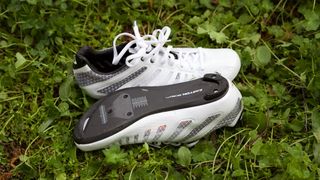
Giro Empire SLX
Giro Empire SLX
Our expert review:
Specifications
Reasons to buy
Reasons to avoid
Giro was one of the first companies to put laces on contemporary pro-level shoes and make them cool. Laces are lighter than BOAs, more aerodynamic, and allow for more precise pressure distribution over the foot. As Giro’s current top level lace model, the Empire SLX retains the shape and design ethos of the original Empire, but with new materials that have made them lighter, more breathable, and more supple. In fact, they’re so thin that they’re see-through, which is just one more reason to make sure your socks don’t have holes.
The wonder material Giro uses is a monofilament mesh that is overlaid in places with a TPU covering that protects it and provides some additional structure. The overall effect is extremely good breathability. So good, in fact, that your feet will get cold, fast. This minimalist construction is also extremely supple—it conforms to your feet easily and comfortably making for a sublime fit. The lace closure allows for infinite adjustment over the foot to optimize how the shoe fits your anatomy.
Soles are made by Easton, using its highest level EC90 carbon and they’re both stiff and very thin. Sole stack height is very good, which creates a strong connection to the pedals. Cleat holes are fixed in place, so do not offer a wide range of fore-aft adjustability. Insoles are made of lightweight foam with a changeable arch support zone. The Empire SLX fits narrow feet with low to medium volume best.
My first test ride in these shoes was on a blustery 50 (F) degree day, and I regretted wearing them without oversocks, as my toes instantly got cold. I typically wear shoes without shoe covers down to around 40 degrees F without issue, but the Empire SLX uppers are too breathable for even mildly chilly temperatures. The flip side of this, of course, is that on warm days they are incredibly cool. If you live in a place with hot summers, these shoes would be worth owning just for the warmest months.
My feet usually get on well with Giro shoes, which tend to be narrow and low-ish volume, and these were no exception. Even during sprint efforts the laces stay locked in and the elastic strap to tuck them in keeps things tidy. Laces are rarely seen on the feet of professional cyclists as they do not permit on-the-bike adjustment as easily as ratcheting dials do, but this is less of a concern for the rest of us, whose races are shorter and whose rides can easily be stopped to tie errant shoelaces as needed.
Best high-end cycling shoe

Shimano S-Phyre RC903 shoes major on foot support
Specifications
Reasons to buy
Reasons to avoid
Shimano's top-of-range S-Phyre RC 903 is an upgrade to the RC902 that has reduced the weight a little, altered the lower BOA Li2 dial's lacing, integrated the heel cup more and increased ventilation.
Shimano makes the shoes in two widths. We found the standard width a little narrow, but the wide fit, although only 3 to 4mm wider, worked better for us. BOA's Li2 dials provide micro adjust meant in both directions, so the shoes could be tightened or loosened whilst riding as conditions changed.
The arch support is adjustable and supports the foot well and the quite narrow toe box and secure heel cup mean that feet feel planted when sprinting with no heel lift or foot movement.
Read more: Shimano S-Phyre RC903 cycling shoes full review
Best heat moldable shoe
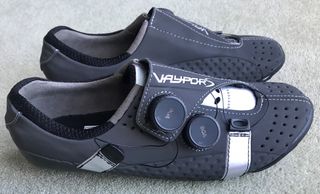
Specifications
Reasons to buy
Reasons to avoid
Bont uses a bathtub design for the unidirectional carbon sole of its Vaypor S road shoe, meaning that it slightly cradles your foot rather than just being underneath. This adds increased stiffness to the shoe which is then continued in the anti-stretch fabric of the upper.
Reliable and hugely adjustable fastening is provided by two BOA Li2 dials, with precise adjustment available even on the move. Despite their stiffness, we found them incredibly comfortable on the bike thanks to the support of the sole.
The Bont Vaypor S is available in a massive range of sizes with half sizes from 36-50 and then four standard and two special order widths. On top of that they are heat moldable in your home oven so you can tweak the fit for comfort (that being said, we found this process only allows small changes to fit).
Read more: Bont Vaypor S road cycling shoes full review
Best for wide feet
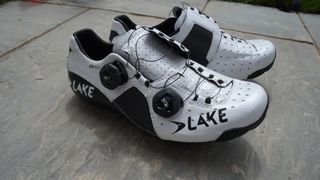
Lake CX403 cycling shoes are built to last
Specifications
Reasons to buy
Reasons to avoid
The Lake CX403 shoes are heat moldable, a popular feature on many higher-end cycling shoes. They're designed as a race shoe rather than an all-rounder and we found them a bit stiff and with a low volume for everyday use but perfect for shorter blasts where the efficient power transfer really shines.
A mix of soft leather and stiff carbon fiber in the uppers aims to provide comfort along with support in all the appropriate places. Two independent BOA dials allow the instep and forefoot to be adjusted separately for improved personalization of fit.
They're easy to mold both at a dealer and at home and you can repeat the process multiple times, making them a good option if your feet are an awkward shape for off-the-peg cycling shoes.
Read more: Lake CX403 shoes cycling shoes full review
Best for Comfort

Quoc M3 Air offers superb support and comfort
Quoc M3 Air
Our expert review:
Specifications
Reasons to buy
Reasons to avoid
The Quoc M3 Air shoes are Quoc’s high-performance road race shoes. Featuring a unidirectional carbon fibre sole that offers great levels of sole stiffness. Foot support is superb with adjustable arches and ball-of-foot relief built into the vibration dampening insoles. If I had to find a flaw with the fit, I would want a little more security in the heel for big sprint efforts out of the saddle. The easy wipe-down PU leather upper is nice and supple and in combination with a tongueless design, it moulds to your foot without any pinching. The mesh panels found on both toe boxes aid with ventilation nicely.
The BOA style retention dials feature micro-adjustments when tightening, as well as a twist to release function and do a great job of securing your foot for high-intensity efforts. The Quoc-designed dials do however lack micro-adjustments for loosening, which is a function found on L-Series BOA systems used by Fizik, Shimano and Bont.
The weight of the shoes is competitive at 253g per shoe in size 45. Priced as a high-end shoe the M3 Air is still a fair chunk cheaper than many of the competitors. Overall the shoes are exceptionally stiff, yet offer a good level of support and comfort.
• Read our full Quoc M3 Air road bike show review
Best for cooling
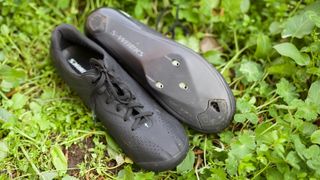
Specialized S-Works Torch Lace
Specialized S-Works Torch Lace
Our expert review:
Specifications
Reasons to buy
Reasons to avoid
The S-Works Torch Lace shares almost all of the same features as the BOA-equipped S-Works Torch shoe, with one notable difference. The soles and majority of the upper design are identical, except the lace closures which provide a more low-tech means of securing the foot within the shoe. Without the need for structural anchor points to support the BOA dials, the uppers are thinner and more flexible, as is the tongue. This translates to a shoe with fewer pressure points, and one that is lighter. Though laces aren’t currently in vogue, they do offer some advantages. Being able to fine tune the fit of the upper lace by lace creates a very comfortable fit, and they stay put very well over the course of a ride. It’s worth noting too that laces tend to perform very well aerodynamically, as they can “trip” airflow to move it around the foot without sticking. Is this Specialized’s fastest road shoe? It’s possible.
The downside to laces is that they cannot easily be adjusted on the fly. If you’re many hours into a ride and your feet need a little room to breathe, BOAs allow for that easily. Conversely, if you’re in a race readying yourself for a sprint, and need a bit of extra support, BOAs make it very easy to tighten up your shoes quickly. Laces cannot match this adjustability.
The soles have a small vent under the toes, and again, like the Torch, they are slightly wider (by 4 millimeters) than previous iterations. Stiffness is excellent. Specialized does insoles better than almost anyone else. Even in high-end shoes, insoles can sometimes seem like an afterthought, but Specialized has clearly done its homework here—the insole is stiffer and more supportive than many of its competitors, though it doesn’t have adjustable arch support like some.
I found that S-Works Torch Lace performed every bit as well as any BOA-equipped shoe currently on the market. For high-level racers who don’t get their shoes as part of a sponsorship deal, these shoes save $100 versus the S-Works Torch with the exact same sole stiffness and dialed Specialized fit.
Best for arch support
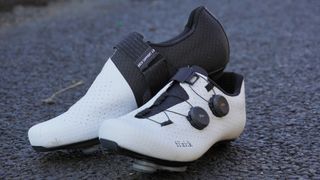
Specifications
Reasons to buy
Reasons to avoid
The Vento Stabilata Carbon is Fizik's top road shoe. Using Fizik's Dynamic Arch Support 2.0 system, it's designed for durability, but at a measured 540g for a pair of size 43.5 it is not quite as light as some competitors.
The mid-sole arch support system uses mesh, adding some extra ventilation to the carbon sole which Fizik claims is the stiffest in its range. As with its other shoes, Fizik has shifted the cleat bolt holes rearward, but not so much as to stop more forward cleat placement if you prefer this.
The synthetic upper feels robust and is easier to clean than fabric models. It's closed by two BOA Li2 dials for excellent micro adjustment and feels moderately wide.
Our tester doesn't suffer from any problems with arch pain, so the arch support system didn't provide any tangible benefits beyond a more cupped feeling, but we still rated the Vento Stabilata Carbon as an excellent pair of racing shoes.
Read more: Fizik Vento Stabilata Carbon full review
Best for sprinting
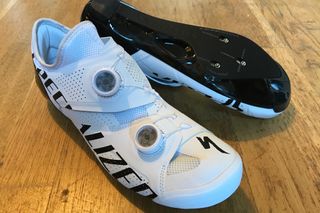
Specialized S-Works Ares cycling shoes povide plenty of foot comfort
Specifications
Reasons to buy
Reasons to avoid
The Specialized S-Works Ares shoe is designed for the pro-level sprinter. It sits on the same carbon sole as the S-Works 7 shoe but comes with an upper that includes a deep, rigid heel cup. There's no separate tongue either, the upper fitting like a sock to avoid overlaps and shave a little weight.
This upper provides the extra 'locked in' feeling that benefits pro-sprinters without impeding the movement of the tendons on the top of the foot and causing discomfort for the preceding 150km of the race.
Our tester found that they had to be put on more carefully than most shoes, ensuring that the 'tongue', sock liner and BOA straps were all sitting correctly, but once on, he found them comfortable to wear. However, the Ares shoes don't work for everyone - your feet need to be the right shape and they work best if your arches are high.
Read more: Specialized S-Works Ares cycling shoes full review
Best lace-up performance
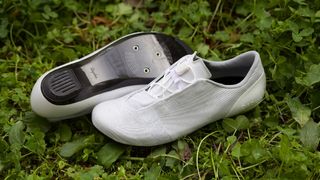
Rapha Pro Team Lace Up
Rapha Pro Team Lace Up
Our expert review:
Specifications
Reasons to buy
Reasons to avoid
Rapha now has several years of shoe designs under its belt, and with these latest versions it is clear the company is making products that can be raced at the highest levels of cycling. The Pro Team Lace Up shoe sits in that upper echelon but offers a slight variation on the norm with laces instead of BOA dials.
The Lace Up shoes are notably sleek in appearance. Uppers are constructed with a woven material Rapha calls Powerweave, developed with materials science company Avery Dennison. The material has a visible textile appearance and breathes well, but, surprisingly, it doesn’t have much stretch. The uppers have only a single seam, tucked out of the way on the inside of the heel. The laces themselves use a quick-pull cord, similar to types seen on trail running shoes. It is faster and easier to tighten, but doesn’t provide the same level of tunability as true laces.
The carbon soles feature a replaceable heel tread piece (removed with a single screw from inside the shoe), but no built-in venting. The cleat hardware is molded in place—there is no fore-aft adjustment; if you run a more extreme cleat position, these shoes may not be able to accommodate it.
I usually need to tighten down my shoes quite a bit in order to get fully locked-in, which sometimes causes discomfort near the ankle if the shoe bunches up. I didn’t have any issues whatsoever with this in the Pro Team Lace Up shoes. The combination of the Powerweave fabric and well-padded tongue makes them feel slipper-like and I noticed and appreciated the feel of a shoe without dials on the outside of the foot.
I found that the speed laces are longer than they need to be, and as a result can be finicky to tuck away. Sole stiffness is quite good—on par with other offerings on the market—but the soles could be made a bit thinner and lighter.
Rapha says the Pro Team Lace up shoes tend to run small, though I found them to fit true to size, at least in terms of length. For those with wider or higher volume feet, however, they will probably be too confining, as the uppers don’t have much give to them. It would be nice to see a wide option introduced by Rapha as well.
Best value
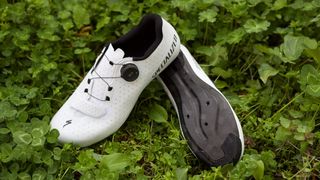
Specialized Torch 2.0
Specialized Torch 2.0
Our expert review:
Specifications
Reasons to buy
Reasons to avoid
Specialized’s Torch 2.0 is an updated model that takes many of the features of the S-Works Torch and brings them to a more accessible price point. The Torch 2.0 uses a single Li2 BOA dial paired with a Velcro strap at the toe. The dimensions and fit of the shoe are the same as its higher end relatives, while the materials and construction techniques are more basic. The sole is carbon, though of a different design than the S-Works shoes, and the heel piece is larger (and not replaceable).
All of the same Body Geometry features are included and the heel cup and toe cap are both integrated underneath the upper, which makes for a very clean, uncluttered appearance. The soles aren’t vented but it’s great to see carbon at this price point. The sole design makes a big difference in keeping weight low, and these shoes punch above their metaphorical weight as a result.
I found that the Velcro strap at the toe doesn’t have much purchase to adjust the fit, and is more or less ornamental. I’m not sure why Specialized elected to include it, but I suppose it at least looks like it does something. I think this feature could be refined further.
On the bike the Torch 2.0 is nearly indistinguishable from a top-end shoe, Specialized or otherwise. The single BOA dial doesn’t offer the precision of two dials, but when you’re riding, that’s not something you think about. Sole stiffness is more than adequate, though Specialized doesn’t provide any ratings for its different soles so it’s hard to say how it compares in terms of numbers. The stability of the larger heel piece makes a huge difference off the bike—they don’t make you feel like a newborn giraffe at the coffee shop. For most riders, these shoes will offer every bit of performance they require.
At its price, the Specialized Torch 2.0 is an excellent value. It’s not an entry-level shoe, but a very solid step up. For that small jump in price, they nearly perform at the level of a pro-level shoe. In fact, I actually prefer the interior shape of the sole of the Torch vs. that of the S-works model, and found my feet were very happy riding long hours in these.
Best mid-range
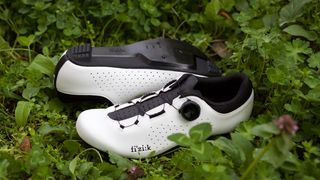
Fizik Vento Omna
Fizik Vento Omna
Our expert review:
Specifications
Reasons to buy
Reasons to avoid
Like the other mid-range shoes reviewed here, the Fizik Vento Omna takes many of its design cues from the top end models, the Vento Infinito Carbon in this case, but brings them to a more affordable price point. It’s a raceable shoe that costs less than half of some of the other performance shoes on the market. Fizik achieves this by using a polyurethane upper, which is slightly thicker and heavier than Microtex, using a single BOA Li2 dial to secure the foot instead of two, and constructing the sole out of nylon (Fizik stiffness index 6 out of 10) instead of carbon.
The uppers are perforated and the soles have a single vent under the toes. The insoles are thicker and softer compared to the Vento Infinito, which makes these shoes very comfortable, if slightly less efficient. Padding around the heel is also more pronounced than in higher end offerings. Fizik subscribes to a philosophy wherein cleats are positioned slightly farther back than on the soles, with the stated aim “to better optimize pedaling efficiency and reduce knee compression.” The soles of the Vento Omna do not have adjustable cleat bolt holes.
Surprisingly, the Vento Omnas weigh the exact same amount as the Vento Infinito shoes, even with the lower-grade sole. For the price, the weight is very good. It’s worth noting that Fizik shoes tend to run a bit big though - I would recommend sizing down at least a half size.
I found these shoes to be very comfortable, even though my foot shape doesn’t jive with Fizik’s last very well. The soles are a little bit flexible, but I didn’t find this to pose an issue outside of sprint-type efforts. It would be nice to see Fizik develop a thinner sole—stack height was noticeable, though that’s common at this price point. Also notable was the design of the heels, which are much wider and more forgiving than other designs out there—they are very walkable shoes. The more flexible soles help with comfort off the bike too.
I didn’t need to avail myself of it during this test, but in past experience, I have found Fizik’s customer service to be exceptional. Fizik once overnighted a replacement saddle to me, directly from Italy, before a race after one of mine broke unexpectedly.
Best mid-range lace-up
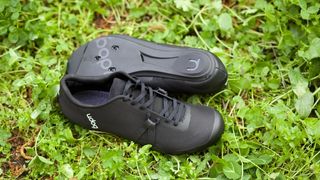
Udog Tensione
Udog Tensione
Our expert review:
Specifications
Reasons to buy
Reasons to avoid
Udog is a newer company that places an emphasis on style and sustainability. The company released its first model in 2021 and currently offers three different road shoes and one gravel shoe. The Tensione is Udog’s lowest level road shoe. It has a vented nylon and carbon sole and a technical mesh upper with a lace closure. The feature that gives the Tensione its name is midshoe harness that allows you to tighten down the laces over the metatarsal region above the cleat and pedal.
The Tensione fits mid-volume feet best and has deep heels that will appeal to riders who like to feel well-supported in that area. The colors are subtle and elegant. The technical mesh upper is breathable and is protected in high-contact areas by a welded rubber layer. The soft material of the upper conforms well to the feet, but the Tensione is only available in whole sizes, so it may not fit everyone optimally.
Shoes are manufactured with some recycled content and the packaging is also made of recycled material. It would be nice to see more cycling companies integrate sustainable manufacturing in simple ways of this nature.
Out of the box, the Tensione is very comfortable. The laces allow for a wide range of adjustment and the width is neither too narrow nor too wide. I was surprised, however, when I went to install cleats in my standard position and realized that I had maxed out the adjustable range of the sole. I run my cleats in a fairly standard position dictated by my metatarsal-phalangeal joints of my feet. Typically this means that the cleats sit more or less in the middle of a cycling shoe’s fore and aft range. On the Tensione, however, it is all the way at the bottom (toward the arch) of the range. For riders who prefer a more midfoot cleat position, this shoe will not permit it.
In the course of my testing I felt like the harness feature Udog has designed has promise, but doesn’t work as well as it could. This area of the foot needs to be locked in for efficient power transfer, and can be hard to adequately lock it down. In practice, however, the laces and harnesses aren’t malleable enough to increase tension reliably in that zone. I experimented with adjusting the lacing pattern of the shoe to see if this would improve things, and had slightly better luck but still felt it could be improved further. Performance-wise, there are more technical options available, but if it's style you seek, Udog is an excellent place to look.
The best cycling shoes: buyer's guide
Cycling shoes are a critical element to ride comfort and there's a lot to think about when choosing the best cycling shoes for your needs. Our buyer's guide helps you to decide.
How should I choose cycling shoes?
Beyond the obvious shoe size, there's a lot to think about when choosing cycling shoes. Even sizing isn't straightforward, as you want a cycling shoe to hold your foot steady to pedal efficiently, so you might need a shoe that's a half size down from your normal.
Carbon soles will be stiffer and increase pedalling efficiency, which is great unless you're expecting to walk in them when a little more give will prove useful. Likewise, they don't have any sole grip.
You also need to make sure that you have the correct cleat holes in the sole for your intended pedal system; either two or three (or sometimes four for Speedplay cleats).
Think too about the closure system. BOA dials are efficient but expensive and single dials may not distribute pressure as evenly as dual dial systems. Ratchets and Velcro are cheaper and can be as efficient. Laces look smart and save weight, but you can't adjust them while riding.
A highly ventilated pair of cycling shoes or shoes with woven uppers will keep your feet cooler in hot conditions, but won't be so good if it's cold and damp.
Finally, there's the price: how much are you prepared to spend? There's no substitute for trying before you buy.
What are the important features of well-fitted cycling shoes?
Cycling is a forefoot sport. Whilst the foot itself doesn’t generate any power, all of the watts produced elsewhere pass through your feet. So not only do poorly fitting shoes create pain, but they can also limit performance.
A former British Cycling physiotherapist and bike fitter at the eponymous Phil Burt Innovation, Phil Burt told us: “If you’re in a wrongly fitted shoe it would manifest as rubbing around the little toe, pain underneath the first and second toe where a lot of people get numbness or pins and needles.”
Touching on the performance element, he added: “The foot and ankle don’t generate any power. All the power comes from your quad and your glute. But you can lose a hell of a lot through badly fitting shoes – for example, if your foot is moving around or over pronating, you can waste a lot of energy.”
The key variables when it comes to cycling shoes are the fastening system, the sole, the cleat style, and of course the fit, although that does depend on whether you've teamed with a pair of good cycling socks.
What are the best cycling shoe fastening systems?
There are basically four different systems used to tighten cycling shoes: Velcro, ratchets, laces, and dials.
Almost all budget cycling shoes use Velcro straps for fastening, basically because it's a cheaper option. For the rider, Velcro straps do a good job of holding the shoe firmly in place but can be difficult to adjust on the move and it can also be a little tricky to get the precise fit you might want.
The other benefit of Velcro straps is that they are light. This means that they can also be found on very expensive lightweight shoes designed specifically for climbers. Over time, the Velcro can lose its effectiveness though, so that the hold on your foot can diminish.
The next step up in the fastening system food chain is ratchets, so look out for some of the great cycling shoes that offer these at a lower price point. A ratchet offers more precise adjustability than Velcro straps, gives a really secure fit, and can also easily be tightened while riding. However, loosening a ratchet is not quite as easy, often requiring two hands. Ratchets are generally found on mid-price shoes and are usually combined with a Velcro strap or two further down the shoe.
At the top of the tree, you have dial closures, the fastening system used on most high-end shoes. In general, these are very secure, are easy to adjust, and can be dialed in (excuse the pun) to give a very precise hold. However, there are differences between different brands of dials. BOA dials offer the current gold standard with higher-end BOAs providing incremental tightening and loosening, while those from other brands and lower-spec BOAs can't always be loosened quite so easily.
The other option on a few other high-end shoes such as the Giro Empires and Specialized S-Works Sub 6 shoes (as well as a few retro-style shoes) is laces. For those interested in marginal gains, laces are very aerodynamic but are also generally very comfy as there's a wider distribution of pressure across the top of the foot and the laces self-adjust to help even it out. However, of course, laces are nigh-on impossible to adjust on the move.
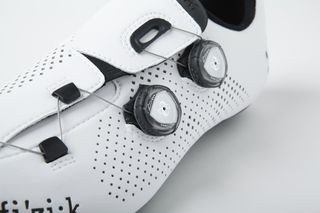
Boa dials offer precise fine-tuning of fit
What is stack height?
Stack height is the distance between the foot and bottom of the shoe. Thinner soles allow you to sit closer to the pedals, keeping body mass compact which helps with aerodynamics and efficiency. Thinner soles also transfer energy through the pedals more effectively. If performance is your aim, thin soles are what you want.
What are the best cycling shoe soles made from?
As with the fastening systems, different types of soles come on different cycling shoes, and of course the more you pay, the more you get.
The main thing that you are looking for with the soles of your cycling shoes is for them to be stiff. This means that when you press down the sole won't bend, meaning that all of the power that you generate is transferred through the sole and into the pedal. The second consideration is weight, with more expensive shoes coming with lighter soles.
Entry-level cycling shoes will generally come with nylon soles, but if you pay a bit more you will get shoes with carbon composite soles (i.e. a mixture of carbon and plastic), while at the top of the scale, you will find carbon-soled shoes. The only thing with some high-end shoes is that some people will find that the ultra-stiff sole may cause discomfort on longer rides, so it's worth reading some reviews before parting with your cash.
As ever, weight is also important, with top-of-the-range carbon shoes often being much lighter than entry-level models.
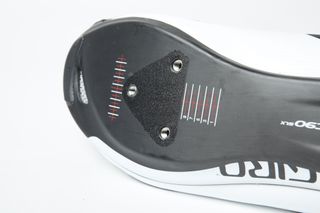
Most road cycling shoes are designed to fit three bolt cleats only
Which cycling shoe cleats are best for me?
While you're looking at the material of the soles of your prospective new cycling shoes, it's worth looking at the type of cleats that they will accommodate, as some will take two-bolt cleats while others will take three-bolt cleats. Some, particularly lower-priced models, let you fit either. Your choice really depends on what type of riding you're doing.
If you're riding off-road or want to have a pair of shoes that are easy to walk in, then go for a pedal system that uses two-bolt cleats such as Shimano SPDs or Crankbrothers Eggbeaters.
However, for most road riding, you want three-bolt cleats which will give you a wider platform for improved power transfer through the pedals. For that reason, mid and high-end shoes will only come with a three bolt pattern.
What should I do to look after my cycling shoes?
Even if you're riding in warm, dry conditions, your cycling shoes are likely to get sweaty inside. Once you take them off, don't just leave them sitting in a plastic bag, but put them somewhere dry where they can air and dry out. It's a good idea to pull out your insoles too, to make sure that the inside of the sole unit dries out fully. Many more expensive cycling shoes may come with a net storage bag to keep them in.
If your shoes get wet, you should take out the insoles and pack the inside of the shoes with scrunched-up newspaper to help soak up the moisture.
Most cycling shoes can be wiped down with a damp cloth, but don't try anything more aggressive to clean them unless the maker's care instructions advise this.
If you're regularly riding in poor conditions, a pair of the best cycling overshoes will help keep your shoes clean. Overshoes tend to wear quickly though; a dedicated pair of winter cycling shoes like the Gaerne Icestorm boots might be a better bet for bad weather. They will have a fully enclosed, waterproof upper and sole, usually with a breathable membrane and insulation, to help keep your feet dry and warm.
Heel support and heel lift are often an issue with this type of winter boot though, so make sure that the fit is good if you go this route with space for some warm socks. Also, consider swapping to winter boots and pedals with two-bolt cleats for their better walkability in the wet or when it's icy so that you're less likely to take a spill on a tile floor at the coffee stop.
Do brands make cycling shoes to fit wider feet?
When brands create cycling shoes, they will typically cater for the “average” individual to accommodate the largest segment of the market. However, with cycling shoes being both incredibly rigid and fixed in place via cleats and pedals, those who fall outside the norm can struggle to find shoes that fit.
Several brands do offer ‘wide fit’ options - these include Sidi, Bont, Shimano and Lake. Lake provides wide toe boxes as well as custom molded heel cups to ensure a good fit all round for those with a wide forefoot and narrow ankle.
We’ve had one wide-footed tester - Cycling Weekly's Owen Rogers, put three pairs of the best cycling shoes for wide feet through their paces. However, former British Cycling physio Phil Burt advises that those looking to solve foot pain ensure they’re solving the correct problem before purchasing.
“You may not have wide feet. It could be that your foot is collapsing, and therefore splaying. A lot of people think they have wide feet, but given an off-the-shelf corrective insole, the problem goes away because they have the support their foot needs.”
You can buy arch-supporting insoles from your local chemist, and of course, there are many brands out there that will create you a custom version should you want something more bespoke.
If you're sure you do have wide feet, and not a need for an insole, then read on.
Do I need custom insoles in my cycling shoes?
Cycling shoes, even pricey ones, often come with fairly basic flat insoles. Since your feet are held in a static position, this can cause discomfort over time. It's worth considering an insole upgrade. Some aftermarket insoles will have an adjustable level of arch support, most will be made of more substantial material than the insoles that come with your shoes and often there will be other extra features like a less flat profile and a midfoot bump to help support your feet better. You can also buy bespoke insoles made to match your feet.
There are a number of different shoes on the market such as the Bont Riot and the Lake CX402 that can be customized through heat molding to fit the shape of your feet. This means that the shoes should perfectly support the arch of your foot, ensuring that you should be very comfortable and power transfer should be improved too as your foot won't move around at all. If you have flat feet or arch-related problems, heat moldable shoes could be the solution.
How do triathlon cycling shoes differ from road cycling shoes?
Triathlon shoes are different from road shoes. If you fancy the idea of doing some triathlons, it might be worth getting a triathlon-specific pair.
Tri shoes are designed to be put on and off quickly while cycling and consequently use an easy-to-open retention system. They often feature a loop on the heel that you can grab for easier access. However, if you ride in cold weather, be aware that tri-shoes often also feature drainage holes and mesh for wet feet so they don't offer much insulation from the cold. If you want road shoes and not triathlon shoes, be sure to check with the retailer that you're getting what you want.
Should I try cycling shoes on before I buy them?
The best way to check the fit of a shoe is to try it on in your local bike shop before purchasing (hopefully you'll make the purchase in the shop too!). It is better to do this in the afternoon or evening as your feet can expand slightly during the day.
Shoe sizing is pretty consistent across brands, particularly when compared to other pieces of cycling clothing – but just because your old and worn-out size 46 shoes were comfortable, it doesn't necessarily mean you can jump straight into a different brand in the same size.
Arch heights, shoe widths, and different fastening systems can all mean that you may find yourself going a size up or down when buying new cycling shoes. Flashier shoes usually come in half sizes, so you can get a good match for your feet. Lower-priced shoes, however, tend to be sold in whole sizes only - they are usually more roomy to start with as well. If your feet are between sizes, that can make choosing the right size tricky. If you're not sure, we'd suggest sizing down.
How we test
Cycling Weekly's team of testers has extensive experience in assessing and writing unbiased reviews of a wide range of cycling products. Since it all involves riding, shoes are central to this and we've tested literally hundreds of different pairs.
We have testers with large feet, small feet, narrow feet and wide feet, so you can be sure that we've taken account of the differences in fit and foot comfort for a wide range of riders and understand what makes for a good pair of cycling shoes.
All our reviews use the same 1 to 5 star rating system:
5 - Superb, best in its class and we couldn’t fault it
4 - Solid product, could be improved
3 - Fine, but a few niggles let this down
2 - Acceptable, needs improvement
1 - Extremely poor, barely worked
Get The Leadout Newsletter
The latest race content, interviews, features, reviews and expert buying guides, direct to your inbox!

After winning the 2019 National Single-Speed Cross-Country Mountain Biking Championships and claiming the plushie unicorn (true story), Stefan swapped the flat-bars for drop-bars and has never looked back.
Since then, he’s earnt his 2ⁿᵈ cat racing licence in his first season racing as a third, completed the South Downs Double in under 20 hours and Everested in under 12.
But his favourite rides are multiday bikepacking trips, with all the huge amount of cycling tech and long days spent exploring new roads and trails - as well as histories and cultures. Most recently, he’s spent two weeks riding from Budapest into the mountains of Slovakia.
Height: 177cm
Weight: 67–69kg
-
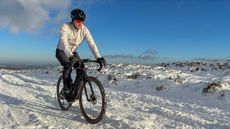 Sidi Algor winter shoe review: warmth and grip even when the trails demand a little walking
Sidi Algor winter shoe review: warmth and grip even when the trails demand a little walkingIf you are venturing off-road in the winter then the Sidi Algor cycling boots will do a good job of keeping your feet toasty
By Tim Russon Published
-
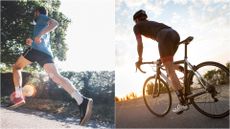 What is the biking equivalent of a 'couch to 5k' running challenge?
What is the biking equivalent of a 'couch to 5k' running challenge?Why it could be easier to train for a longer cycling event than a 30-minute run
By Caroline Dezendorf Published